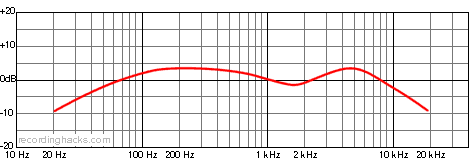 Blue Microphones Baby Bottle
Blue Microphones Baby Bottle
Cardioid Condenser Microphone
The Baby Bottle is a pressure-gradient cardioid condenser microphone, employing an edge-terminated single-membrane large-diaphragm capsule. The diaphragm is a 6-micron mylar film, sputtered with a mixture of gold and aluminum. It is enclosed in a spherical grille with a side-address design. The assembly does not rotate or swivel (unlike some of Blue’s capsule designs).
The mic’s electronics are Class A discrete, with transformerless output. The mic’s self-noise rating, 5.5 dB(A), is among the lowest we’ve seen.
SoundOnSound
It seems to be a very ‘crisp’ microphone, handling transients well on percussion and acoustic guitar, for example. The slightly emphasised presence region means that the mic needs to be positioned and angled carefully if the source is not to sound too hard or edgy, but, conversely, sources did tend to work well within a mix, cutting through cleanly…
Despite the simple stand bracket, the Baby Bottle seemed very resistant to rumble and handling noises.
In comparison with the slightly more expensive Neumann TLM103, I found the Baby Bottle to be about 4dB less sensitive and a couple of decibels noisier — still very impressive results, though! While the BLUE definitely has more ‘presence’ than the Neumann, it also seemed to have a little less ‘air’ and openness, although you would only become aware of this subtle difference in a head-to-head comparison.
MIX
The first thing I noticed was that the Baby Bottle is extremely quiet. (Self-noise is rated at 5.5 dB, A-weighted.) The next thing was the mic’s very high output level, considerably hotter than a typical large-diaphragm condenser, providing lots of additional headroom. Sonically, the Baby Bottle has a very full, rich sound, with a little bump (at approximately 2 kHz) that slightly emphasizes upper mids. The pickup pattern is fairly wide, with a very gradual loss of level as you get further off-axis.
Shipped with a swivel mount. Shockmounts are available separately.
Resolution, 2003
[S]omething that had been niggling in the back of my mind was suddenly brought into focus by one of the musicians, who commented that the lollipop capsule looked just like an SM58. Anybody who has ever tried putting an SM57 or SM58 through a really high-quality mic preamp will immediately know what I’m talking about — a rounded, mellow sound but with a surprising openness and clarity in the top-end… with the greatest respect to BLUE, that’s what the Baby Bottle had started to remind me of…
[I]t is a microphone with a character all its own, and one that works extremely well in a lot of contexts.
The Baby Bottle, like several of Blue’s early products, was the subject of an intellectual property dispute in 2006, when the original manufacturer, SIA Scruples/Violet Design, attempted to register a lookalike microphone with the EU’s “Office for the Harmonization of the Internal Markets” — essentially the EU’s trademark office. The OHIM called Scruples’ registration invalid, awarding the IP rights to Martin Saulespurens of BLUE. For a time, this mic was known as the Violet JZ-6 or JZ6.
The Baby Bottle won Electronic Musician’s Editor’s Choice award for 2003.
The Blue Microphones Baby Bottle is also known as: Baby Bottle, JZ6, JZ-6.
The mic was released in 2001.
Specifications
| Frequency Response - CardioidClick Graph to Compare! |
|---|
 |
| Pickup Patterns | Pads & Filters |
|---|---|
|
Cardioid
(33.5 mV/Pa; 20 - 20,000 Hz) |
|
| Capsule Dimensions | Impedance | SPL/Noise |
|---|---|---|
| Diaphragm diameter: 26mm Diaphragm gauge: 6 microns |
50 Ohms (Low) | Max SPL: 133 dB Self-noise: 5.5 dB(A) |
| Weight | Length | Max Diameter | Interface(s) |
|---|---|---|---|
| 350g (12.35oz) | 222mm (8.74'') | 45mm (1.77'') |
|
| Power Specifications |
|---|
|
Did we get anything wrong on this page? Please let us know!

